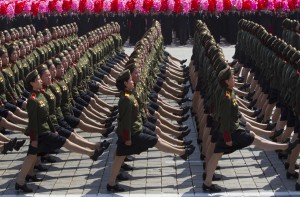 North Korea Population 2013
North Korea Population 2013
The most recent estimate for the population of the Democratic People’s Republic of Korea is that there are about 24.554 million people, which is an increase of about 0.84% from the last record of population. Historically, the population of North Korea has always been less than that of the population of South Korea. Near the latter end of the 20th century and the beginning of the 21st century, the difference in the populations became even greater. Based on the total land area and the total population of the country, the population density of North Korea is 513.8 people per square mile.
Demographics of North Korea
The largest ethnic group in the Democratic People’s Republic of Korea is native Korean. About 99.8% of the population identifies as Korean. The other 0.2% identifies as Chinese. A trivial portion of the population identifies as Japanese, but not enough to make up any portion of a percent of the population. The official language of the country is the Korean Language. Even though there are different dialects throughout the language, there is no language difference across the borders of the two Korean Republics.
Religion in North Korea
Religion in North Korea has an interesting role in society. Even though a lot of people may perceive that the majority of the population is not religious, the Buddhist religion has a large impact on the society. Some claim that Christianity is a persecuted religion in the country. In fact, some sources say that the country has the most severely persecuted Christians.
Korea Division
The division of North Korea and South Korea stems from the end of WWII. The Allies were victorious over the Axis powers in 1945, after which point the United States of America forced Japan to relinquish its 35 year rule over Korea. After the surrender of Japan at the end of World War II, Japanese rule was brought to an end. The Korean peninsula was divided into two occupied zones in 1945 along the 38th parallel, with the northern half of the peninsula occupied by the Soviet Union and the southern half by the United States, in accordance with a prior arrangement between the two world powers, where United Nations–supervised elections were intended to be held for the entire peninsula shortly after the war.
Projected Population of North Korea
The population of the Democratic People’s Republic of Korea is expected to increase up until the years 2040-2045. The birth rates are projected to decrease from about 14.2 births per 1000 people to about 12.0 births per 1000 people. However, the death rates are expected to increase from about 10.2 deaths per 1000 people to about 12.8 deaths per 1000 people. Also, there is almost an average net migration rate of 0 people. So the number of immigrants into the country just about equals the number of people emigrating from the country.
State of North Korea
Historical Population of North Korea
The population of the Democratic People’s Republic of Korea has always increased over the course of the last half a century. However, at the beginning of the 21st century, the increase in population began to level off.
| Year | Population (millions) |
| 1960 | 10.95 |
| 1965 | 12.32 |
| 1970 | 14.25 |
| 1975 | 16.07 |
| 1980 | 17.24 |
| 1985 | 18.72 |
| 1990 | 20.14 |
| 1995 | 21.77 |
| 2000 | 22.89 |
| 2005 | 23.75 |
| 2010 | 24.35 |
Projected Population of North Korea Table
| Year | Population (millions) | Percent Increase |
| 2015 | 24.837 | 1.2% |
| 2020 | 25.322 | 2.0% |
| 2025 | 25.788 | 1.8% |
| 2030 | 26.150 | 1.4% |
| 2035 | 26.366 | 0.83% |
| 2040 | 26.396 | 0.11% |
| 2045 | 26.347 | -0.18% |
| 2050 | 26.248 | -0.38% |


